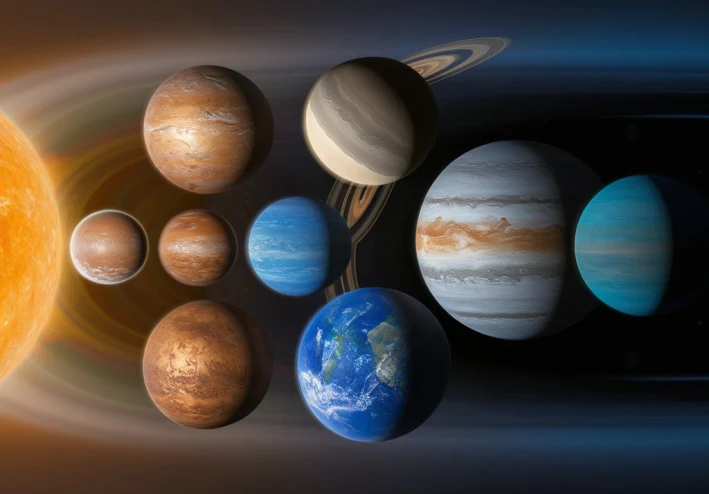
?The Number of Planets Discovered So Far
?The Number of Planets Discovered So Far
Planets are celestial bodies orbiting the sun in defined paths. Our solar system has eight main planets: Mercury, Venus, Earth, Mars, Jupiter, Saturn, Uranus, and Neptune. Planets are distinguished by their brightness in the night sky due to reflected light when visible from Earth. They are typically classified as elements of the solar system, varying in size, composition, atmospheric components, and surface features. They usually consist of various materials including rocks, minerals, and gases. Terrestrial planets like Earth, Mars, and Mercury are mostly composed of rocks and minerals, while gas giants like Jupiter, Saturn, Uranus, and Neptune consist mainly of hydrogen and helium gases with thick layers of various clouds. The exact compositions of planets vary depending on their types and formation histories.
Ancient Civilizations' View of Planets:
In ancient civilizations, planets held great importance in astronomy and astrology. The seven visible planets with the naked eye - Mercury, Venus, Mars, Jupiter, Saturn, Uranus, and Neptune - were considered significant celestial bodies whose motions were closely observed for predictions, calendrical purposes, and various religious and agricultural uses. These planets inspired ancient civilizations and formed an integral part of their astronomical, religious, and philosophical beliefs. For instance, in Sumerian and Babylonian civilizations, each planet had associated deities and symbolic representations, while in ancient Egyptian civilization, planets were linked to specific gods and represented creative and symbolic forces.
Number of Discovered Planets:
After the announcement of the first discovery of an extrasolar planet in 1992, interest in finding planets outside our solar system, known as exoplanets, increased. Thousands of exoplanets have been discovered so far using various techniques, including direct observation, continuous monitoring of stellar brightness changes, and precise measurements of stars' and planets' angular motion. As of 2022, the number of discovered exoplanets has surpassed 5,000, with most of them being analyzed and characterized using space telescopes like Kepler and other ground-based and space-based projects.
Regarding planets within our solar system, the official count remains at eight as known for decades. These planets are Mercury, Venus, Earth, Mars, Jupiter, Saturn, Uranus, and Neptune. Pluto, once considered the ninth planet, was reclassified in 2006 as a dwarf planet due to its smaller size and different orbital characteristics.
The search for planets, both within and outside our solar system, continues with advanced techniques and ongoing interest in understanding the universe, its formation, and evolution. With each new discovery, we move a step closer to unraveling the secrets of planetary formation and perhaps even the existence of life elsewhere in the cosmos.
Planets in the Solar System:
1- Earth:
The fifth-largest planet in the solar system, with an equatorial diameter of about 7,926 miles (12,756 kilometers). Earth is the third planet from the sun, orbiting at an average distance of 93 million miles (149.7 million kilometers. (
2-Venus:
The sixth-largest planet in the solar system. Venus has a diameter almost equal to that of Earth, with an equatorial diameter of about 7,521 miles (12,104 kilometers). It is the second planet from the sun, orbiting at an average distance of 67.2 million miles (108 million kilometers), and is closer to the sun than Earth by about 26 million miles (42 million kilometers. (
3- Mars:
The red planet, the seventh-largest planet in our solar system. Mars has a diameter approximately half that of Earth, with an equatorial diameter of about 4,221 miles (6,792 kilometers). It is the fourth planet from the sun, orbiting at an average distance of 141.6 million miles (227.9 million kilometers), and is about 49 million miles (79 million kilometers) away from the sun.
4- Jupiter:
The largest planet in the solar system. It is about 11 times wider than Earth, with an equatorial diameter of 88,846 miles (about 142,984 kilometers). Jupiter is the fifth planet from the sun, orbiting at an average distance of 483.7 million miles (778 million kilometers), about five times farther from the sun than Earth.
5- Saturn:
Known for its stunning icy rings, Saturn is the second-largest planet in our solar system. It is about nine times wider than Earth, with an equatorial diameter of approximately 74,898 miles (about 120,536 kilometers). Saturn is the sixth planet from the sun, orbiting at an average distance of 889.8 million miles (1.4 billion kilometers), about 9.5 times farther from the sun than Earth.
6- Uranus:
Uranus is the third largest planet in our solar system. It is about four times wider than Earth, with an equatorial diameter of approximately 31,763 miles (51,118 kilometers). Uranus is the seventh planet from the sun, orbiting at an average distance of 1.8 billion miles (2.9 billion kilometers). It is about 19 times farther from the sun than Earth.
7- Neptune:
Neptune is the fourth largest planet. It is about four times wider than Earth and has an equatorial diameter of approximately 30,775 miles (49,528 kilometers). Neptune is the eighth and farthest planet from the sun, orbiting at an average distance of 2.8 billion miles (4.5 billion kilometers). Neptune is about 30 times farther from the sun than Earth.
8- Mercury:
Mercury is the smallest planet in our solar system. Its width is slightly more than one-third of Earth's width, with an equatorial diameter of about 3,032 miles (4,880 kilometers). Mercury is the closest planet to the sun, orbiting at an average distance of 36 million miles (58 million kilometers). Mercury is closest to the sun by 57 million miles compared to Earth.
In conclusion:
The number of planets in the universe has surpassed 5,000. While it's fantastic that astronomers have discovered as much as they can see, they know well that their telescopes are not accurate or powerful enough to see all dark planets. Planets can be very small or very far away because sometimes they are distant from Earth, so astronomers can always ensure the existence of some undiscovered planets.
































